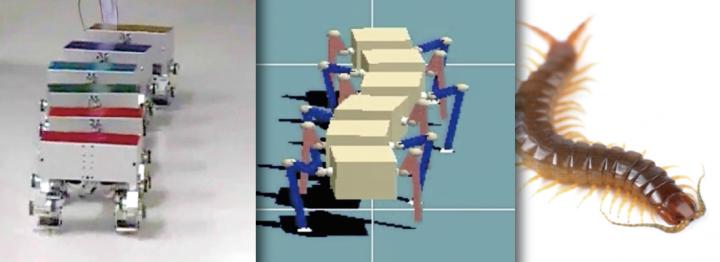Hey robot, shimmy like a centipede

What makes centipedes move with such agility? Researchers at Kyoto University have used simulations and robotics to find the answer -- and a surprising truth. Credit: Kyoto University
Centipedes move quickly. And when one is coming directly at you, you might not care to spend a moment pondering its agility.
So perhaps our lack of understanding about just why centipedes move with such dexterity, even over obstacles, has been related to fear. But undeterred, researchers at Kyoto University have asked precisely this question, and have turned to computer simulations and ultimately robotics to find an answer.
What they have uncovered is a surprising insight into the mechanics of locomotion itself, namely that taming instability — a factor that might be a disadvantage — is a key to the centipede's success.
“During their locomotion, many legs are in contact with the ground to support the body against gravity and produce propulsive and decelerating forces,” explains lead scientist Shinya Aoi. “These many legs are physically constrained on the ground, and this constraint can impede their locomotion maneuverability.”
Centipedes overcome these constraints by harnessing instability, producing the creature's characteristic undulating movement.
“Our group developed a mathematical model of centipedes and found that the straight walk becomes unstable and body undulations appear through a supercritical Hopf bifurcation by changing the locomotion speed and body axis flexibility,” continues Aoi, referring to a mathematical description of the walking system's tipping point from stable to unstable.
First with computer models and then with segmented, multi-legged robots, the team was able to replicate the centipede's movement, including the wave-like body motion, as described in a paper in the online journal Scientific Reports.
But Aoi and his colleagues are not satisfied with merely taming creepy crawlies.
“This study provides clues to unresolved issues of intelligent motor functions of animals, and meaningful insight for biological sciences,” he says, pointing out that much remains unknown about the exact mechanics of animal locomotion.
And further down the line, such knowledge could lead to better motion for robots — no matter how many legs they may have.
Media Contact
All latest news from the category: Information Technology
Here you can find a summary of innovations in the fields of information and data processing and up-to-date developments on IT equipment and hardware.
This area covers topics such as IT services, IT architectures, IT management and telecommunications.
Newest articles

NASA: Mystery of life’s handedness deepens
The mystery of why life uses molecules with specific orientations has deepened with a NASA-funded discovery that RNA — a key molecule thought to have potentially held the instructions for…

What are the effects of historic lithium mining on water quality?
Study reveals low levels of common contaminants but high levels of other elements in waters associated with an abandoned lithium mine. Lithium ore and mining waste from a historic lithium…

Quantum-inspired design boosts efficiency of heat-to-electricity conversion
Rice engineers take unconventional route to improving thermophotovoltaic systems. Researchers at Rice University have found a new way to improve a key element of thermophotovoltaic (TPV) systems, which convert heat…



